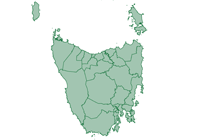Value added by industry is an indicator of business productivity in Burnie City. It shows how productive each industry sector is at increasing the value of its inputs. It is a more refined measure of the productivity of an industry sector than output (total gross revenue), as some industries have high levels of output but require large amounts of input expenditure to achieve that.
By comparing the value added of each industry sector to a regional benchmark, you can clearly see the structure of Burnie City’s economy. This can be done by directly comparing the percentage contribution of each industry to the total output, relative to the benchmark, or by using a location quotient, where a number greater than one indicates a high concentration of that industry and less than one indicates a lower concentration.
To see what contribution each industry makes to the state or region, see the Industry sector analysissection. To understand the value of a worker in each industry, view this dataset in conjunction with Worker productivity data, and to see the relationship of value added to the total size of the economy, go to the Gross Regional Product section.
Detailed notes about how the figures are derived can be found in the specific topic notes section.
Data source
National Economics (NIEIR) - Modelled series
Current area:
Current benchmark:
Comparison year:
| Value added by industry sector | |||||||||
|---|---|---|---|---|---|---|---|---|---|
| Burnie City | 2022/23 | 2017/18 | Change | ||||||
| Industry | $m | % | Tasmania | $m | % | Tasmania | 2017/18 - 2022/23 | ||
| Agriculture, Forestry and Fishing | 126.7 | 7.9 | 11.0 | 104.5 | 7.9 | 11.2 | +22.2 | ||
| Mining | 164.0 | 10.2 | 4.9 | 119.2 | 9.0 | 5.2 | +44.8 | ||
| Manufacturing | 93.1 | 5.8 | 5.8 | 107.0 | 8.1 | 7.6 | -13.9 | ||
| Electricity, Gas, Water and Waste Services | 19.0 | 1.2 | 2.9 | 14.7 | 1.1 | 3.2 | +4.3 | ||
| Construction | 87.8 | 5.5 | 7.9 | 58.9 | 4.5 | 7.7 | +28.8 | ||
| Wholesale Trade | 69.4 | 4.3 | 2.6 | 36.7 | 2.8 | 3.1 | +32.7 | ||
| Retail Trade | 81.4 | 5.1 | 5.0 | 81.3 | 6.2 | 5.7 | +0.1 | ||
| Accommodation and Food Services | 26.4 | 1.6 | 3.0 | 25.3 | 1.9 | 2.9 | +1.1 | ||
| Transport, Postal and Warehousing | 137.7 | 8.6 | 5.6 | 137.7 | 10.4 | 5.2 | -0.1 | ||
| Information Media and Telecommunications | 62.3 | 3.9 | 3.7 | 20.6 | 1.6 | 3.3 | +41.7 | ||
| Financial and Insurance Services | 52.6 | 3.3 | 5.7 | 49.9 | 3.8 | 5.8 | +2.8 | ||
| Rental, Hiring and Real Estate Services | 32.7 | 2.0 | 2.1 | 25.7 | 2.0 | 2.0 | +6.9 | ||
| Professional, Scientific and Technical Services | 41.2 | 2.6 | 4.1 | 33.5 | 2.5 | 3.6 | +7.7 | ||
| Administrative and Support Services | 35.5 | 2.2 | 2.4 | 50.8 | 3.9 | 2.0 | -15.3 | ||
| Public Administration and Safety | 89.1 | 5.5 | 7.2 | 85.0 | 6.4 | 7.2 | +4.1 | ||
| Education and Training | 117.3 | 7.3 | 6.7 | 90.6 | 6.9 | 7.1 | +26.6 | ||
| Health Care and Social Assistance | 335.7 | 20.9 | 16.1 | 247.6 | 18.8 | 14.2 | +88.1 | ||
| Arts and Recreation Services | 3.1 | 0.2 | 1.2 | 1.6 | 0.1 | 1.2 | +1.5 | ||
| Other Services | 32.9 | 2.0 | 2.0 | 27.3 | 2.1 | 1.9 | +5.6 | ||
| Total industries | 1,607.8 | 100.0 | 100.0 | 1,318.1 | 100.0 | 100.0 | +289.7 | ||
Source: National Institute of Economic and Industry Research (NIEIR) ©2023. Compiled and presented in economy.id by .id (informed decisions). NIEIR-ID data are adjusted each year, using updated employment estimates. Each release may change previous years’ figures. Learn more Please refer to specific data notes for more information | |||||||||


Dominant groups
An analysis of the valued added by industry sectors in Burnie City in 2021/22 shows the three largest industries were:
- Health Care and Social Assistance (336 million or 20.9%)
- Mining (164 million or 10.2%)
- Transport, Postal and Warehousing (138 million or 8.6%)
In combination these three industries accounted for 637 million in total or 39.6% of the total value added by industry in the Burnie City.
In comparison, the same 3 industries in Tasmania accounted for 16.1% in Health Care and Social Assistance; 4.9% in Mining and 5.6% in Transport, Postal and Warehousing.
The major differences between the value added by industries of Burnie City and Tasmania were:
- A larger percentage of value added by Mining (10.2% compared to 4.9%)
- A larger percentage of value added by Health Care and Social Assistance (20.9% compared to 16.1%)
- A smaller percentage of value added by Agriculture, Forestry and Fishing (7.9% compared to 11.0%)
- A larger percentage of value added by Transport, Postal and Warehousing (8.6% compared to 5.6%)
Emerging groups
The total value added by industry in Burnie City $increased by 290 million between 2017/18 and 2022/23.
The largest changes in the value added by industries between 2017/18 and 2022/23 in Burnie City were for:
- Health Care and Social Assistance (+$88 million)
- Mining (+$45 million)
- Information Media and Telecommunications (+$42 million)
- Wholesale Trade (+$33 million)
